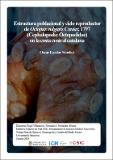Por favor, use este identificador para citar o enlazar a este item:
http://hdl.handle.net/10261/176855COMPARTIR / EXPORTAR:
 SHARE
BASE SHARE
BASE
|
|
| Visualizar otros formatos: MARC | Dublin Core | RDF | ORE | MODS | METS | DIDL | DATACITE | |

| Título: | Estructura poblacional y ciclo reproductor de Octopus vulgaris Cuvier, 1797 (Cephalopoda: Octopodidae) en la costa central catalana |
Autor: | Escolar Sánchez, Oscar CSIC ORCID | Director: | Villanueva, Roger CSIC ORCID; Fernández-Álvarez, Fernando Ángel CSIC ORCID | Fecha de publicación: | 19-oct-2018 | Editor: | Universidad de Barcelona CSIC - Instituto de Ciencias del Mar (ICM) |
Resumen: | The common octopus Octopus vulgaris Cuvier, 1797 is an important fishery resource with a high demand worldwide. Recently, its landings are decreasing, while both fishery effort and price are increasing. Its catches could fluctuate annually, due to its short life cycle and the interannual changes of the environmental factors which could affect the recruitment survival. The present study attempts to assess the current state of the O. vulgaris population structure and the periods of sexual maturity on the Central Catalonian coast. To attain this objective, this study samples the landings of the artisanal and trawler fleet measuring different biological parameters: the weight, the mantle length, the sex, the sexual maturity stage and the presence/absence of sperm in both female spermatheca and oviducts. Moreover, several samplings were made on board a fishing boat to analyze octopus below the commercial size. Additionally, the presence of recently settled juveniles was reported and studied for first time aboard a fishing vessel using an opportunistic sampling based on common artisanal fishing methods. This study characterized a female maturity peak of females that range from march to October. On the contrary, males were sexually mature during all the sampling period. Captured octopuses showed significant differences in sizes between months: the biggest individuals were caught during May, June and July, while the smallest ones were caught from September and October. However, trawlers landed smallest individuals than artisanal fleet along the survey. The presence of a juvenile peak on may is discussed and several hypotheses to explain its presence are proposed. All this new knowledge was summarized in a theoretical model of the annual cycle of O. vulgaris in the Central Catalonian coast and its expected that it might help to improve its exploitation if fisheries co-management plans are developed for this species in the future | Descripción: | Trabajo final presentado por Oscar Escolar Sánchez para el Máster en Oceanografía y Gestión del Medio Marino de la Universitat de Barcelona (UB), realizado bajo la dirección del Dr. Roger Villanueva López y del Dr. Fernando Ángel Fernández-Álvarez del Institut de Ciències del Mar (ICM-CSIC).-- 39 pages, 26 figures, 8 tables, 1 annex | URI: | http://hdl.handle.net/10261/176855 |
| Aparece en las colecciones: | (ICM) Tesis |
Ficheros en este ítem:
| Fichero | Descripción | Tamaño | Formato | |
|---|---|---|---|---|
| Escolar_TFM_2018.pdf | 2,91 MB | Adobe PDF |  Visualizar/Abrir |
CORE Recommender
Page view(s)
306
checked on 23-abr-2024
Download(s)
182
checked on 23-abr-2024
Google ScholarTM
Check
NOTA: Los ítems de Digital.CSIC están protegidos por copyright, con todos los derechos reservados, a menos que se indique lo contrario.
